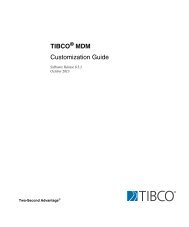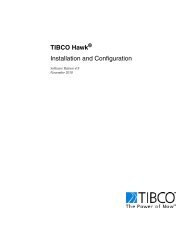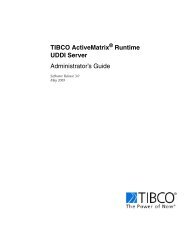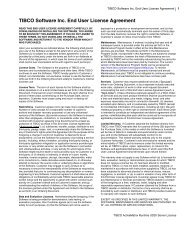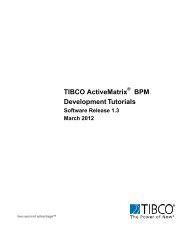TIBCO Spotfire Server 3.2.2 - TIBCO Product Documentation
TIBCO Spotfire Server 3.2.2 - TIBCO Product Documentation
TIBCO Spotfire Server 3.2.2 - TIBCO Product Documentation
You also want an ePaper? Increase the reach of your titles
YUMPU automatically turns print PDFs into web optimized ePapers that Google loves.
Technical Reference<br />
Jakarta Service<br />
Log<br />
This file cannot be viewed in the UI, you must open the actual log file.<br />
Actual file located in<br />
/tomcat/logs/spotfire/jakarta_service_yyyyMM<br />
dd.log, where yyyyMMdd is replaced by the log file’s creation date.<br />
This log file contains information about when the Tomcat service is<br />
started and stopped.<br />
11.1.6 Export Log File<br />
By clicking on the Export Log File button, you can save the current log file to disk.<br />
Note: This only exports the <strong>Spotfire</strong> <strong>Server</strong> log, not the logs of the Configuration and<br />
Console and <strong>Spotfire</strong> Controller.<br />
11.1.7 Log Out<br />
For security reasons, always make sure to exit your browser when logging out of<br />
<strong>Server</strong> Logs and Diagnostics. This makes sure no session cookies are retained.<br />
11.2 <strong>Server</strong>.xml<br />
<strong>Spotfire</strong> <strong>Server</strong> is implemented as a Tomcat web application. For this reason, it uses a<br />
standard Tomcat web application configuration file, server.xml, to store information it<br />
needs when starting. This file is stored in /tomcat/conf/>. You<br />
should only need to make changes to this server if you need to change port numbers<br />
after installation, or if you need to tweak Tomcat behavior. Note that each <strong>Spotfire</strong><br />
<strong>Server</strong> in a cluster has a server.xml. Therefore, if you need to make changes to it, you<br />
need to make those changes to all the servers in the cluster.<br />
The standard server.xml delivered with <strong>Spotfire</strong> <strong>Server</strong> looks like this:<br />
<br />
<br />
<br />
<br />
<br />



